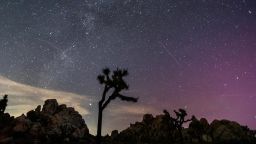Science
Experience the November Supermoon and Southern Taurid Meteor Shower

A remarkable celestial event is set to occur this week as November’s full beaver supermoon coincides with the peak of the Southern Taurid meteor shower. The supermoon will reach its peak at 8:19 a.m. ET on November 1, 2023, but stargazers should look for it in the evening hours when it will be above the horizon.
The term “beaver moon” is derived from the time of year when beavers prepare for winter by strengthening their dams and lodges. This full moon is also known as the “digging moon” by the Tlingit people, the “deer rutting moon” by the Dakota, and the “frost moon” by the Cree, according to The Old Farmer’s Almanac. This supermoon marks the second of three consecutive supermoons this year, with the phenomenon occurring when the moon is at perigee, its closest point to Earth.
Dr. Alissa Bans, director of undergraduate studies in the physics department at Emory University, noted that while the size difference may not be easily perceptible to the naked eye, the supermoon represents the moon at its brightest. “It’s so subtle that the human eye does not pick up the superness of it,” she explained. If weather conditions hinder visibility, the Virtual Telescope Project will provide a livestream of the full moon from Manciano, Italy, starting at 2 p.m. ET on November 1.
In addition to the supermoon, the Southern Taurid meteor shower will peak at 8 a.m. ET on November 1. According to EarthSky, this shower typically produces only about five meteors per hour, making it less intense than other meteor showers. Robert Lunsford, fireball report coordinator for the American Meteorological Society, explained that the Taurids originate from debris from the small comet 2P/Encke, which has the shortest known orbit of any comet at just 3.3 years.
Lunsford noted that the Taurid meteor shower has previously produced impressive fireballs around Halloween, leading to its nickname as the “Halloween fireballs.” This year, the encounter with the Taurids is particularly noteworthy as predictions suggest that observers may witness some larger meteors, which are more likely to create fireballs.
For those eager to catch a glimpse of the meteor shower, Lunsford advised finding a location with dark skies, away from urban light pollution. He recommended viewing after sunset and before the moon rises to its highest point on the night of November 1. While the Taurids are more favorable for viewers in the Northern Hemisphere, they can still be observed in the Southern Hemisphere, although the meteors may be obscured by the lower horizon.
Looking ahead, several other meteor showers are anticipated in the coming months. The American Meteor Society and EarthSky provide a schedule of peak dates for these events. Additionally, stargazers should keep an eye out for the last full supermoon of the year, drawing the attention of astronomy enthusiasts worldwide.
-

 Sports3 weeks ago
Sports3 weeks agoSteve Kerr Supports Jonathan Kuminga After Ejection in Preseason Game
-

 Top Stories2 weeks ago
Top Stories2 weeks agoMarc Buoniconti’s Legacy: 40 Years Later, Lives Transformed
-

 Entertainment3 weeks ago
Entertainment3 weeks agoZoe Saldana Advocates for James Cameron’s Avatar Documentary
-

 Business3 weeks ago
Business3 weeks agoTyler Technologies Set to Reveal Q3 2025 Earnings on October 22
-

 Science3 weeks ago
Science3 weeks agoChicago’s Viral ‘Rat Hole’ Likely Created by Squirrel, Study Reveals
-

 Politics3 weeks ago
Politics3 weeks agoDallin H. Oaks Assumes Leadership of Latter-day Saints Church
-

 Lifestyle3 weeks ago
Lifestyle3 weeks agoKelsea Ballerini Launches ‘Burn the Baggage’ Candle with Ranger Station
-

 Lifestyle3 weeks ago
Lifestyle3 weeks agoDua Lipa Celebrates Passing GCSE Spanish During World Tour
-

 Health3 weeks ago
Health3 weeks agoCommunity Unites for Seventh Annual Mental Health Awareness Walk
-

 Health3 weeks ago
Health3 weeks agoRichard Feldman Urges Ban on Menthol in Cigarettes and Vapes
-

 Business3 weeks ago
Business3 weeks agoMLB Qualifying Offer Jumps to $22.02 Million for 2024
-

 Sports3 weeks ago
Sports3 weeks agoPatriots Dominate Picks as Raiders Fall in Season Opener









